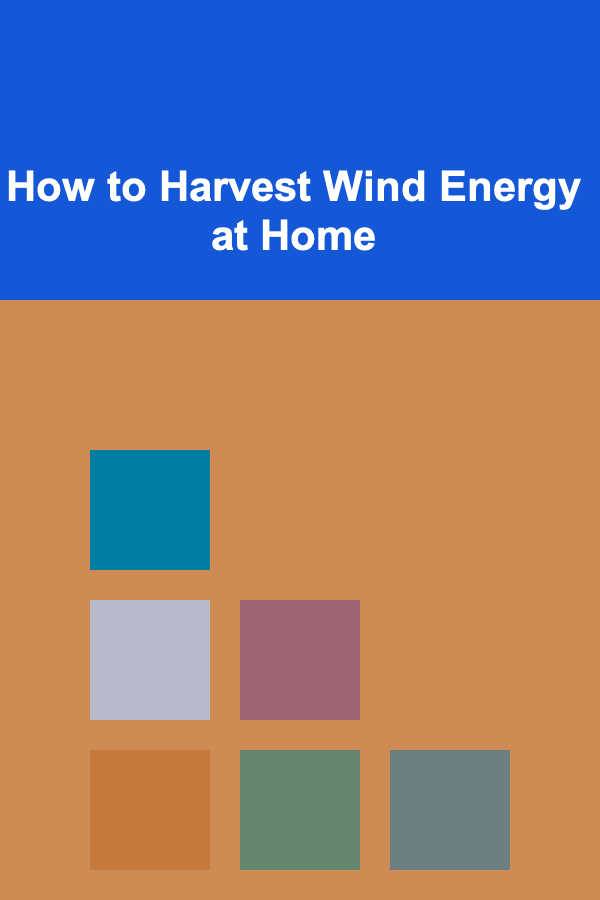
How to Harvest Wind Energy at Home
ebook include PDF & Audio bundle (Micro Guide)
$12.99$10.99
Limited Time Offer! Order within the next:

As the world becomes increasingly aware of the environmental impact of fossil fuels, there has been a significant shift toward renewable energy sources, with wind energy standing out as one of the most promising. While large-scale wind farms capture the attention of governments and corporations, home-based wind energy systems are also growing in popularity as a way for individuals to reduce their carbon footprint and save money on energy bills. This article explores how to harvest wind energy at home, including the steps involved, the technology used, the benefits, and the challenges you may face.
Introduction to Wind Energy
Wind energy is a form of solar energy, as wind is created by the heating of the Earth's surface by the sun. When the sun heats the land and water, warm air rises, creating areas of high and low pressure. This movement of air is what we know as wind. Wind turbines, which harness this moving air, convert kinetic energy into electrical energy, offering an alternative to burning fossil fuels.
In recent years, the focus has shifted toward making wind energy accessible to homeowners. Small-scale residential wind turbines can generate electricity for homes, and depending on your location, can provide a significant portion of your energy needs. However, there are several factors to consider before embarking on the installation of a wind energy system at home.
Understanding Wind Energy for Home Use
Wind energy can be harnessed for a variety of applications, from heating and cooling to powering electrical appliances. The process of generating wind energy at home typically involves the installation of a wind turbine system, which can generate electricity to be used in the home. There are two main types of wind turbines used for residential purposes:
- Horizontal-Axis Wind Turbines (HAWTs): These are the most common type of wind turbine. They have blades that rotate around a horizontal axis and are often seen in large wind farms. For residential use, they typically range from 1 to 10 kW of power, sufficient for a small to medium-sized home.
- Vertical-Axis Wind Turbines (VAWTs): These turbines have a vertical rotor shaft and are less commonly used but are gaining attention for their ability to operate in turbulent wind conditions. They are often more compact and can be installed in smaller spaces, though they tend to be less efficient than HAWTs.
Benefits of Harvesting Wind Energy at Home
The benefits of harvesting wind energy at home are manifold, not only from an environmental standpoint but also from an economic one. Here's a closer look at the advantages:
A. Environmental Impact
Wind energy is a clean and renewable source of energy. Unlike fossil fuels, wind energy does not produce greenhouse gases or contribute to air pollution. By installing a wind turbine at home, homeowners can reduce their reliance on fossil fuels, contributing to a reduction in carbon emissions and global warming.
B. Cost Savings
Wind turbines can help reduce electricity bills significantly. By generating your own power, you can either reduce your overall energy consumption or offset the electricity you buy from the grid. Depending on your location, you may even qualify for financial incentives or tax credits that can further offset the initial installation costs. In the long term, this can lead to substantial savings, particularly in areas with high energy prices.
C. Energy Independence
One of the key benefits of wind energy is the potential for energy independence. By generating your own electricity, you can become less reliant on the electrical grid, which is especially useful in areas prone to power outages or in rural locations where the cost of extending the power grid is prohibitively expensive.
D. Low Operating Costs
Once installed, wind turbines have relatively low operating and maintenance costs. Wind turbines can last for decades with proper maintenance, and there are few ongoing expenses beyond occasional repairs or part replacements.
Steps to Harvest Wind Energy at Home
Harvesting wind energy at home involves several steps, from evaluating your wind resources to installing and maintaining the turbine. Here's a step-by-step guide to help you through the process.
A. Assessing Wind Resources
Before investing in a wind turbine, it's crucial to assess the wind resources in your area. The amount of energy your turbine can generate depends on how much wind is available. The first step is to measure the average wind speed at your location.
To get an accurate understanding of your wind resources, you can:
- Check Local Wind Maps: Some organizations, such as the U.S. Department of Energy, offer wind resource maps that show average wind speeds in different regions.
- Install a Wind Meter (Anemometer): If you want a more accurate reading, you can install an anemometer at your site. This device measures wind speed and helps you determine whether your location is suitable for wind energy generation.
In general, the ideal wind speed for residential wind turbines is between 9 and 14 mph (14 to 22 km/h), with speeds greater than 15 mph (24 km/h) being even more beneficial. However, even at lower wind speeds, smaller turbines can still produce useful amounts of electricity.
B. Choosing the Right Wind Turbine
Once you've assessed your wind resources, the next step is to choose a wind turbine that matches your energy needs. The key factors to consider when choosing a turbine include:
- Power Output: Residential turbines typically range from 1 to 10 kW of power, which is enough for a small to medium-sized home. For a household that uses about 10,000 kWh annually, a 5 to 10 kW turbine is usually appropriate.
- Wind Turbine Design: Choose between horizontal-axis and vertical-axis turbines, depending on the wind conditions and space available at your home.
- Noise Levels: Some wind turbines can be noisy, so it's important to choose one that operates quietly if noise is a concern.
- Durability: Look for a turbine made from high-quality materials that can withstand the elements and last for many years.
C. Installing the Wind Turbine
Installing a wind turbine involves several steps, from site preparation to securing permits. Here's a brief overview of the process:
- Choose the Right Location: To optimize wind capture, install your turbine in an open area away from obstructions like trees and buildings that could block the wind. The turbine should also be mounted at a height sufficient to capture high-speed winds.
- Install the Tower: The tower is the support structure for the wind turbine, and it must be sturdy enough to handle the weight and stress of the turbine. Towers can be freestanding or guyed, depending on the design.
- Mount the Turbine: Once the tower is in place, the turbine itself is mounted at the top of the tower. This typically involves securing the rotor and ensuring that all electrical connections are properly set up.
- Connect to the Grid or Battery Storage: Once the turbine is operational, you can connect it to the electrical grid or to a battery storage system. Grid-tied systems allow you to sell excess energy back to the utility company, while off-grid systems require a battery bank to store electricity for later use.
D. Maintenance and Monitoring
Wind turbines require regular maintenance to ensure they remain efficient and operational. Some common maintenance tasks include:
- Inspecting and cleaning the blades: Over time, dust, dirt, and debris can accumulate on the blades, which can reduce efficiency. Cleaning and inspecting the blades regularly will help maintain optimal performance.
- Checking the mechanical components: Regularly check for any wear or damage to the turbine's mechanical components, including bearings, gears, and the generator.
- Monitoring performance: Many modern wind turbines come with monitoring systems that allow you to track the performance of the turbine, including wind speeds, energy generation, and operational status.
It's also important to follow the manufacturer's maintenance recommendations and schedule professional inspections periodically.
Challenges of Harvesting Wind Energy at Home
While the idea of harvesting wind energy at home is appealing, there are some challenges to be aware of:
A. Initial Investment
The initial cost of purchasing and installing a wind turbine can be significant, typically ranging from $5,000 to $70,000, depending on the size and complexity of the system. While there are incentives and rebates available in some regions, the upfront cost can be a barrier for many homeowners.
B. Wind Variability
Wind energy is highly variable. While some areas have consistent winds, others may experience sporadic or low wind speeds, which can reduce the effectiveness of a home-based wind turbine. In locations with unpredictable wind, a hybrid system that combines wind energy with solar power may be a better option.
C. Zoning and Permits
Before installing a wind turbine, homeowners must check local zoning laws and regulations. In some areas, there are restrictions on turbine height, noise levels, and aesthetic impact. You may also need to obtain permits for installation, which can take time and involve additional costs.
D. Aesthetic and Noise Concerns
Wind turbines, especially larger models, can be visible from a distance and may raise aesthetic concerns. Additionally, some turbines generate noise, which can be disruptive to neighbors. Choosing a quiet model and installing it away from living areas can help mitigate these issues.
Conclusion
Harvesting wind energy at home is a powerful way to reduce your environmental impact, lower energy costs, and increase energy independence. While the installation of a wind turbine requires careful consideration of factors such as wind resources, turbine type, location, and cost, the long-term benefits can be significant. With the right approach, homeowners can harness the power of wind to create a sustainable, reliable energy source right at home. As technology continues to advance and more incentives become available, the future of home-based wind energy looks brighter than ever.

How to Create a Grocery Shopping Checklist for Busy Families
Read More
How to Defrost Your Freezer Properly
Read More
How To Hydrate Combination Skin Effectively
Read More
How to Utilize ChatGPT for Language Translation
Read More
Start Here: How to Start a Freelance Career
Read More
10 Tips for Camping in Extreme Heat
Read MoreOther Products

How to Create a Grocery Shopping Checklist for Busy Families
Read More
How to Defrost Your Freezer Properly
Read More
How To Hydrate Combination Skin Effectively
Read More
How to Utilize ChatGPT for Language Translation
Read More
Start Here: How to Start a Freelance Career
Read More